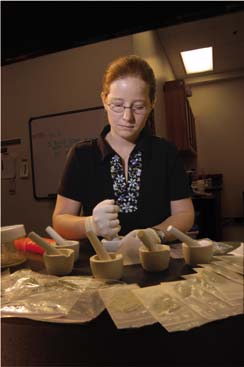Two UF doctoral candidates were chosen to receive Canon National Parks Science Scholarships based on research that will benefit ecosystems on land and under sea.
by Joseph Kays When the creators of the Canon National Parks Science Scholars Program for the Americas set out “to encourage the best graduate students in the Americas to conduct research critical for conserving national parks throughout the region,” they must have had Ashley Morris and Rikki Grober-Dunsmore in mind. The ecosystems the two University of Florida doctoral students study could not be more different, but their commitment to providing park managers with sound scientific data on which to make decisions about the future of our national parks is identical. “I really feel like I’m contributing something through this work,” says Morris of her research on the effects of global warming on forest range and diversity. “I try to pick projects that will have an impact. We need more interactions between the academics and the people in the parks.” “I’m very management oriented,” echoes Grober-Dunsmore, who is studying ways to apply successful terrestrial management techniques to coral reef ecosystems. “I always look at the utility of science for answering management questions.” Morris and Grober-Dunsmore were two of only eight doctoral students from the United States, Canada, Mexico, the countries of Central and South American and the Caribbean who were chosen in an extremely rigorous selection process to receive $78,000 scholarships in 2002. “It is a great credit to what the University of Florida is doing in training its Ph.D. students that two of them were selected in the same year,” says Gary Machlis, a National Parks Service visiting senior scientist and coordinator of the Canon program. Machlis says 110 scholarship proposals were winnowed down in a scientific review “equivalent to a very competitive National Science Foundation grant.” The American Association for the Advancement of Science recruited more than 40 scientists from throughout the Americas to serve as volunteer reviewers, with the top proposals sent to AAAS headquarters in Washington, D.C. for a two-day final review. “The criteria are scientific merit, scientific creativity and application to park conservation,” Machlis says. “While at least some of the research has to be done in a national park, the value to the park is not the only priority. We also want these students to use our national parks as laboratories to expand human knowledge. It’s very much science for parks and parks for science.”
Family TreesRaised in Alabama, Ashley Morris earned her bachelor’s degree from the University of the South in Sewanee, Tenn., and her master’s degree from the University of Tennessee, and she says feels “a special connection” with Great Smoky Mountains National Park. “It
is an amazing place, with a diversity that is almost as great as the tropics,”
Morris says of the thickly forested park that encompasses 800 square miles
along the Tennessee-North Carolina border. Morris was one of a handful of students who followed botanists Doug and Pam Soltis to the University of Florida from Washington State University to establish a new program in plant genetics. She says she developed an interest in quaternary paleoecology — the study of Ice Age ecosystems and environments — while working on her master’s degree at the University of Tennessee. Two professors there, Paul and Hazel Delcourt, had conducted significant research on the historic ranges of modern trees using pollen found in core samples from the bottom of lakes. But
this approach worked only for species whose pollen is abundant and wind-borne.
Pines, for example, are well represented in the fossil pollen record,
but orchids, which rely on insects to spread their pollen, are not. “The Smokies are very diverse, floristically,” Morris says, “but there is very little fossil pollen data from this region because there are very few, if any, of the deep, still lakes that you need to get the core samples. Most of the water in the Smokies is in rocky, fast-moving streams.” So Morris is applying her expertise in population genetics to try to confirm what the pollen record shows and to develop a method of extending understanding of ancient ecosystems to more species in more areas.
By performing DNA sequencing on samples of four species of trees that are common across the eastern United States — American beech, witch-hazel, anise and sweetgum — Morris hopes to create a genetic “family tree of trees.” It is a massive data-collection effort. Morris has mapped the ranges of the four species and selected 30 to 50 evenly distributed sites across the eastern United States. She intends to collect and analyze up to 30 samples for each of the four species from each of the sites. “How I collect samples will affect results,” she says. “This is a particularly comprehensive undertaking. Usually, the availability of samples drives where they are collected from. The researcher relies on people to send them samples from various places.” In the laboratory, the DNA in Morris’ samples is reflected on her computer in a seemingly endless progression of the letters A, G, T and C — the initials for the four base nucleotides that make up DNA: adenine, guanine, thymine and cytosine. Fifty years after James Watson and Francis Crick used a Tinkertoy-like model with pieces labeled A, G, T and C to create the double-helix structure of DNA, Morris employs sophisticated computer software to compare the DNA of different samples and highlight where they differ. “If I sequence enough samples, and get enough variation from region to region, I can get structure to the data,” she says. “I can create a phylogenetic tree and determine which individuals came first. Ultimately, you can show the progression of changes.” Morris pulls out a grid that looks just like the one genealogists use to map a family’s history, but instead of grandma’s name on one line and great-grandma’s on the next, it has different variations of beech tree DNA. The samples with less genetic variation are assumed to be from younger populations that haven’t had time to diversify as much as older populations. “By getting sequences from across the country, we are actually retracing time,” she says. “As I tell my mother, we are retracing the footsteps of these trees.” Perhaps most exciting to Morris, the National Park Service has agreed to incorporate her work into ongoing research it is performing on the effects of temperature change on species distribution. “The theory is that during the last Ice Age, many of these species were limited to river valleys, where there were slightly different microclimates,” Morris says. “If that’s true, everything we have today came from those refugial areas. “By surveying the Smokies, where we don’t have good fossil data, we can help to support or refute this theory,” she adds. “If we can show that the river canyons of the Smoky Mountains served as glacial refuges, so may they serve as greenhouse refuges as the Earth heats up.” “The National Park Service has already done research on what they think would happen as temperatures increase, but it is based on the average habitat requirements of the trees,” Morris says. “By incorporating genetic data into their models, we should be able to get a lot more realistic picture of the effects of global warming.” And a more accurate picture could lead to better management decisions. “For the National Park Service and the Forest Service to make management decisions, they have to know how much diversity there will be,” Morris says. “If we can predict Beech trees, for example, will be limited as temperatures increase, we may want to bank their genes for future use.”
Coral Reef Champion
Overfishing, habitat destruction and global warming threaten an estimated 60 percent of the world’s reefs. In response to these threats, over the last 20 years marine protected areas, or MPAs, have become a popular way of providing refuge to exploited species and helping alleviate threats to marine biodiversity. But although there are currently about 300 MPAs in the United States, they represent only about 1 percent of the ocean within U.S. jurisdiction, and only about 10 percent of that protected area is afforded the highest level of protection, where fishing and other extractive activities are precluded. “The next 10 years are crucial for deciding where to locate marine protected areas. Because a limited amount of the marine realm will be protected from accelerating human activities, the decisions that we make about their placement and design are crucial for conserving sustainable, representative coral reef ecosystems,” Grober-Dunsmore says. The challenge — according to the U.S. departments of Commerce and the Interior, which are jointly charged with managing the nation’s MPAs — is that “complex processes … make marine systems fascinating to study, difficult to characterize and even harder to manage.” “To date, the focus of most MPAs has been on single habitats, potentially neglecting the functional linkages among habitats,” Grober-Dunsmore says. “However, the opportunity still exists to design and manage MPAs as entire ecosystems, based on the habitat requirements of important reef-associated fishes.” This approach has been used successfully for years on land, but until recently the technology has not been available to identify different reef habitats on such a large scale. However, a program by the National Oceanographic and Atmospheric Administration (NOAA) to develop benthic, or bottom, habitat maps of U.S. reefs offers an opportunity to apply terrestrial management techniques to aquatic environments. The maps are based on thousands of aerial photographs, from which researchers identify coral reefs, seagrass beds, mangrove forests, and other important marine resources. Grober-Dunsmore says reef ecologists have historically worked at the plot level, counting species in representative areas of a reef to try to understand the entire ecosystem. But this approach is “slow, expensive and labor intensive,” she says. So she has proposed a broader approach that compares the data from plot-level fishing surveys with the benthic habitat maps to come up with statistically valid generalizations about what combinations of habitat will produce the most benefit. “We’re looking for a detectable relationship between abundance and diversity of fishes and the habitats,” Grober-Dunsmore says.
So far, NOAA has produced benthic habitat maps for most of the Florida Keys and the U.S. Virgin Islands, an area Grober-Dunsmore knows well after spending several years there with the U.S. Geological Service’s Biological Resources Division. During that time, and since she started her doctoral work at UF, Grober-Dunsmore has sampled 42 reefs around the island of St. John, spending hundreds of hours underwater counting the number of snapper, grouper and grunt. Her research has shown some correlation between the abundance of sea grass and the abundance of fish, but she adds that the number of fish around St. John has been so depressed by fishing, development and other stresses that when she tried to apply her theories to 22 other reefs, “my statistical power to detect relationships was compromised.” Now she is looking to the less-developed Turks and Caicos Islands southeast of the Bahamas, an area she says is just now being discovered as a tourist destination. “I was absolutely blown away by the abundance of fish in the Turks and Caicos compared to the Virgin Islands,” Grober-Dunsmore says. “They have more protected marine area per acre of land than any other nation on Earth, but their national park system is threatened as development pressures may cause legislators to take land out of protection or ease restrictions.” Because benthic habitat maps do not yet exist for the Turks and Caicos, Grober-Dunsmore is having to create them herself from aerial photographs. She has to conduct fish surveys of the area, as well. “I couldn’t do this research without this scholarship,” Grober-Dunsmore says. “Boats, gas, air — all cost money.” “Marine protected areas are thought by many to be an essential means of conserving threatened marine species and/or their habitats. Unfortunately, there is a great deal of debate concerning the design, development and implementation of MPAs for conservation purposes,” says Thomas Frazer, assistant professor of fisheries and aquatic sciences at UF and chair of Grober-Dunsmore’s doctoral committee. “Rikki’s research will provide insights to help resolve some of these issues and will be a valuable contribution to the scientific and resource management communities.” Since the Canon program was established in 1997, about 55 student papers have been published by scholarship recipients, including several in such prestigious journals as Science and Ecology. “Every year we bring together all the Canon Scholars,” says Machlis of the National Park Service. “They learn from each other and become colleagues. They share data. In effect, we are creating an invisible college. “Our goal is to create the next generation of conservation scientists and leaders. By around 2015 or 2020, young people like Ashley and Rikki will be ready to assume full responsibility for conservation.” Rikki
Grober-Dunsmore |
 |
|
|
RGP Home
| Sponsored Research
| Graduate Education
| Technology Licensing Administrative Services | Research Communications | Contact the Webmaster |




